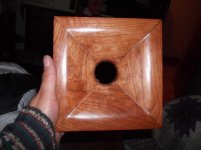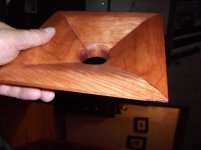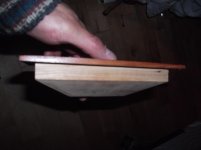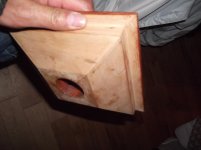Hello all,
I have constructed a waveguide from the collective info here on DIYaudio and the Elliot Sound Products website. The waveguide has an opening of 7.5" set at 120 degrees total. The transition flare to 0 degrees was done with a parrabol in mind. The throat opening is designed to accept a 1and 1/8th" dome tweeter throat length is 1" and flared again with a parrabol in mind. I say in mind as I did not follow a mathematical formula to come to this but do know what one is from the graph made using Earle Geddes numbers. Though I have not tested these yet I do believe they, at the vary least better time align the tweeter from the woofer baffle plane! Thoughts on this?
kingfisher
I have constructed a waveguide from the collective info here on DIYaudio and the Elliot Sound Products website. The waveguide has an opening of 7.5" set at 120 degrees total. The transition flare to 0 degrees was done with a parrabol in mind. The throat opening is designed to accept a 1and 1/8th" dome tweeter throat length is 1" and flared again with a parrabol in mind. I say in mind as I did not follow a mathematical formula to come to this but do know what one is from the graph made using Earle Geddes numbers. Though I have not tested these yet I do believe they, at the vary least better time align the tweeter from the woofer baffle plane! Thoughts on this?
kingfisher
Attachments
Measure them in see what you find. They look good to me. I usually form waveguides from putty before i build them in hard material.
Frequency Tests Needed
The throat transition, in its current form, presents a diffraction edge to the outbound wave (where the slope of the horn walls is abruptly changed). While this will increase wave front dispersion it will also generate back-waves that return to the diaphragm. This condition will also aggravate the transverse modes it the throat section as well. At frequencies where this occurs, responses irregularities will be observed in the tweeter output.
If the tweeter dome is occupying most of this space, its presence will, to some degree, mitigate these response anomalies.
Please let me know what your frequency response tests reveal.
Recommend you test the tweeter mounted in flat baffle as well as in the horn.
Regards,
WHG
Hello all,
I have constructed a waveguide from the collective info here on DIYaudio and the Elliot Sound Products website. The waveguide has an opening of 7.5" set at 120 degrees total. The transition flare to 0 degrees was done with a parrabol in mind. The throat opening is designed to accept a 1and 1/8th" dome tweeter throat length is 1" and flared again with a parrabol in mind. I say in mind as I did not follow a mathematical formula to come to this but do know what one is from the graph made using Earle Geddes numbers. Though I have not tested these yet I do believe they, at the vary least better time align the tweeter from the woofer baffle plane! Thoughts on this?
kingfisher
The throat transition, in its current form, presents a diffraction edge to the outbound wave (where the slope of the horn walls is abruptly changed). While this will increase wave front dispersion it will also generate back-waves that return to the diaphragm. This condition will also aggravate the transverse modes it the throat section as well. At frequencies where this occurs, responses irregularities will be observed in the tweeter output.
If the tweeter dome is occupying most of this space, its presence will, to some degree, mitigate these response anomalies.
Please let me know what your frequency response tests reveal.
Recommend you test the tweeter mounted in flat baffle as well as in the horn.
Regards,
WHG
WaveGuide
Suggestions!? I have worked on this project per the info compiled. I am sure there is quite a lot of room for improvement too! So, if I were to make the throat area less shallow this may lessen the change to tranistion. Should I make this as shallow as possible or leave material for sound to travel down. I read the Pantent pending design of Peavey ona horn they use in there PA speakers. The throat on this unit travels some distance before entering the flared area. If I read this correctly the throat angle is also in contantion? Too shallow, Not enough?
Francis
Suggestions!? I have worked on this project per the info compiled. I am sure there is quite a lot of room for improvement too! So, if I were to make the throat area less shallow this may lessen the change to tranistion. Should I make this as shallow as possible or leave material for sound to travel down. I read the Pantent pending design of Peavey ona horn they use in there PA speakers. The throat on this unit travels some distance before entering the flared area. If I read this correctly the throat angle is also in contantion? Too shallow, Not enough?
Francis
Suggestions!? I have worked on this project per the info compiled. I am sure there is quite a lot of room for improvement too! So, if I were to make the throat area less shallow this may lessen the change to tranistion. Should I make this as shallow as possible or leave material for sound to travel down. I read the Pantent pending design of Peavey ona horn they use in there PA speakers. The throat on this unit travels some distance before entering the flared area. If I read this correctly the throat angle is also in contantion? Too shallow, Not enough?
Francis
You'd need a reference to confirm the previous posters concerns so i'd say take a 'wait and see' approach until flat baffle and WG loaded measurments are complete. Only then will you/we be able to identify it's performance potential.
- Status
- Not open for further replies.



